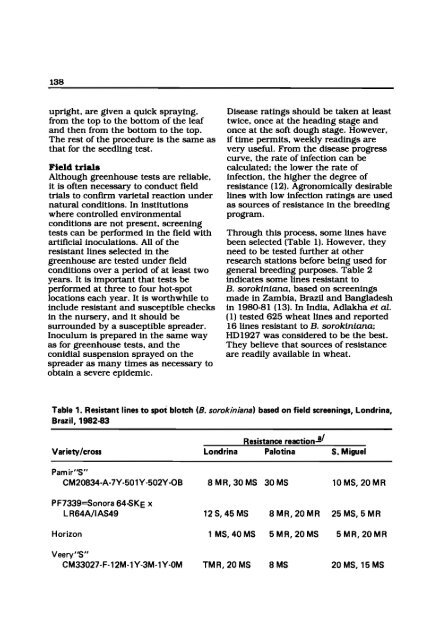the Symposium on Wheats for More Tropical Environments - cimmyt
the Symposium on Wheats for More Tropical Environments - cimmyt
the Symposium on Wheats for More Tropical Environments - cimmyt
- No tags were found...
Create successful ePaper yourself
Turn your PDF publications into a flip-book with our unique Google optimized e-Paper software.
138upright, are given a qUick spraying,from <str<strong>on</strong>g>the</str<strong>on</strong>g> top to <str<strong>on</strong>g>the</str<strong>on</strong>g> bottom of <str<strong>on</strong>g>the</str<strong>on</strong>g> leafand <str<strong>on</strong>g>the</str<strong>on</strong>g>n from <str<strong>on</strong>g>the</str<strong>on</strong>g> bottom to <str<strong>on</strong>g>the</str<strong>on</strong>g> top.The rest of <str<strong>on</strong>g>the</str<strong>on</strong>g> procedure is <str<strong>on</strong>g>the</str<strong>on</strong>g> same asthat <strong>for</strong> <str<strong>on</strong>g>the</str<strong>on</strong>g> seedling test.Field trialsAlthough greenhouse tests are reliable,it is often necessary to c<strong>on</strong>duct fieldtrials to c<strong>on</strong>firm varietal reacti<strong>on</strong> undernatural c<strong>on</strong>diti<strong>on</strong>s. In instituti<strong>on</strong>swhere c<strong>on</strong>trolled envir<strong>on</strong>mentalc<strong>on</strong>diti<strong>on</strong>s are not present, screeningtests can be perf<strong>on</strong>ned in <str<strong>on</strong>g>the</str<strong>on</strong>g> field withartificial inoculati<strong>on</strong>s. All of <str<strong>on</strong>g>the</str<strong>on</strong>g>resistant lines selected in <str<strong>on</strong>g>the</str<strong>on</strong>g>greenhouse are tested under fieldc<strong>on</strong>diti<strong>on</strong>s over a period ofat least twoyears. It is important that tests beperf<strong>on</strong>ned at three to four hot-spotlocati<strong>on</strong>s each year. It is worthwhile toinclude resistant and susceptible checksin <str<strong>on</strong>g>the</str<strong>on</strong>g> nursery, and it should besurrounded by a susceptible spreader.Inoculum is prepared in <str<strong>on</strong>g>the</str<strong>on</strong>g> same wayas <strong>for</strong> greenhouse tests, and <str<strong>on</strong>g>the</str<strong>on</strong>g>c<strong>on</strong>idial suspensi<strong>on</strong> sprayed <strong>on</strong> <str<strong>on</strong>g>the</str<strong>on</strong>g>spreader as many times as necessary toobtain a severe epidemic.Disease ratings should be taken at leasttwice, <strong>on</strong>ce at <str<strong>on</strong>g>the</str<strong>on</strong>g> heading stage and<strong>on</strong>ce at <str<strong>on</strong>g>the</str<strong>on</strong>g> soft dough stage. However,if time pennits, weekly readings arevery useful. From <str<strong>on</strong>g>the</str<strong>on</strong>g> disease progresscurve, <str<strong>on</strong>g>the</str<strong>on</strong>g> rate of infecti<strong>on</strong> can becalculated; <str<strong>on</strong>g>the</str<strong>on</strong>g> lower <str<strong>on</strong>g>the</str<strong>on</strong>g> rate ofinfecti<strong>on</strong>, <str<strong>on</strong>g>the</str<strong>on</strong>g> higher <str<strong>on</strong>g>the</str<strong>on</strong>g> degree ofresistance (12). Agr<strong>on</strong>omically desirablelines with low infecti<strong>on</strong> ratings are usedas sources of resistance in <str<strong>on</strong>g>the</str<strong>on</strong>g> breedingprogram.Through this process, some lines havebeen selected (Table 1). However, <str<strong>on</strong>g>the</str<strong>on</strong>g>yneed to be tested fur<str<strong>on</strong>g>the</str<strong>on</strong>g>r at o<str<strong>on</strong>g>the</str<strong>on</strong>g>rresearch stati<strong>on</strong>s be<strong>for</strong>e being used <strong>for</strong>general breeding purposes. Table 2indicates some lines resistant toB. soroktntana, based <strong>on</strong> screeningsmade in Zambia, Brazil and Bangladeshin 1980-81 (13). In India, Adlakha et al.(1) tested 625 wheat lines and reported16 lines resistant to B. soroktntana;HD1927 was c<strong>on</strong>sidered to be <str<strong>on</strong>g>the</str<strong>on</strong>g> best.They believe that sources of resistanceare readily available in wheat.Table 1. Resistant lines to spot blotch (8. sorokiniana) based <strong>on</strong> field screenings, L<strong>on</strong>drina,Brazil, 1982-83Resistance reacti<strong>on</strong>~/Variety/cross L<strong>on</strong>drina Palotina S. MiguelPamir"S"CM20834-A-7Y-501 Y-502Y-DB 8 MR, 30 MS 30 MS 10 MS, 20 MRPF7339=S<strong>on</strong>ora 64-SKe xL R64A/1 AS49Horiz<strong>on</strong>Veery"S"CM33027-F-12M-1Y-3M-1Y-OM12S,45MS 8MR,20MR 25MS,5MR1 MS,40MS 5MR,20MS 5MR,20MRTMR, 20 MS 8 MS 20 MS, 15 MS

















